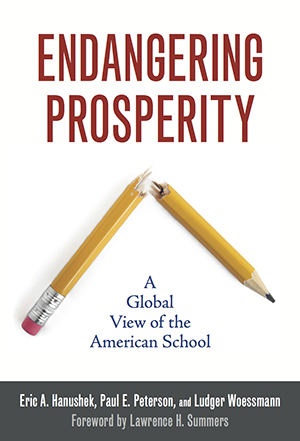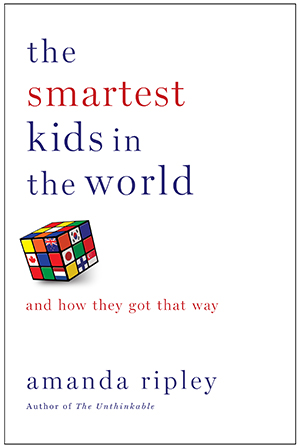Endangering Prosperity: A Global View of the American School
By Eric A. Hanushek, Paul E. Peterson, and Ludger Woessmann
Foreword by Lawrence H. Summers
Brookings Institution Press, 2013, $22.95; 147 pages.
 The Smartest Kids in the World: And How They Got That Way
The Smartest Kids in the World: And How They Got That Way
By Amanda Ripley
Simon & Schuster, 2013, $28.00; 310 pages.
As reviewed by Nathan Glazer
Endangering Prosperity, with three distinguished authors and an eminent introducer, is devoted to one major point: the United States is truly falling behind not only the East Asian countries that for some time have scored best in international comparisons of educational achievement, but also a good part of the developed world, including its neighbor, Canada. The book eschews the difficult effort of determining just why the United States, undoubtedly a leader in educational attainment and possibly educational achievement 40 or 50 years ago, now trails other nations in both. Nor does it discuss what specific measures might enable us to catch up. Rather, through international comparative analysis, the volume demonstrates that educational achievement, particularly in mathematics and science, is closely related to and probably a prime mover in economic advancement, leading to the conclusion that if we do not improve our educational achievement, our economic predominance is also threatened.
The book’s distinctive contribution to the discussion of comparative educational achievement is its ability to slot the various states of the United States into charts of international achievement by linking statistically the scoring system of the National Assessment of Educational Progress (NAEP), which measures achievement by individual state, to that of the Program for International Student Assessment (PISA), which tracks achievement around the globe. And so we discover that Massachusetts, faring best among American states, stands far up the scale, between Switzerland and Japan (but still behind Shanghai, Singapore, Hong Kong, Korea, Finland, and Taiwan); that northeastern and upper midwestern states score at the top in the United States; and that the United States as a whole is way back in the rankings, between Portugal and Ireland.
Endangering Prosperity is meticulous in considering alternative explanations of differences in economic development. Although the volume does not attempt to analyze the causes of our relative decline or how it might be overcome, it shows a preference for some explanations and solutions: the book asserts, for example, that “the school work force—teachers, principals, superintendents, other administrators, and ancillary personnel—too often favor only those changes to the status quo that enhance their income and lighten their workload.” Simple solutions proposed by vested interests, such as “higher expenditures, smaller classes…added support and administrative personnel” will not do. “Structural reform” is needed: the authors are not specific, but their approval of “legislative actions to alter teachers’ evaluations, teachers’ tenure, teachers’ layoff rules, bargaining issues, and more, in a range of states, Wisconsin, Indiana, Florida, Oklahoma, Ohio, Colorado” gives a strong hint as to what they favor.
 Does the experience of countries that have gone far beyond us in educational achievement support this preference? In The Smartest Kids in the World, we have a fascinating book to help us ponder just what has driven educational achievement in the countries of East Asia and, surprisingly, Finland, which stands at the top in achievement in Europe. It was the intriguing idea of Amanda Ripley, an investigative journalist, to track the experiences of three American high-school students who, dissatisfied with the offerings in their home schools, decided to go abroad for a year and attend school in two countries that surpass us in educational achievement―Korea and Finland―and in Poland, which has shown remarkably rapid improvement in PISA tests. Three more diverse education systems and environments could hardly be imagined, and the chances of their teaching the same lesson are unlikely.
Does the experience of countries that have gone far beyond us in educational achievement support this preference? In The Smartest Kids in the World, we have a fascinating book to help us ponder just what has driven educational achievement in the countries of East Asia and, surprisingly, Finland, which stands at the top in achievement in Europe. It was the intriguing idea of Amanda Ripley, an investigative journalist, to track the experiences of three American high-school students who, dissatisfied with the offerings in their home schools, decided to go abroad for a year and attend school in two countries that surpass us in educational achievement―Korea and Finland―and in Poland, which has shown remarkably rapid improvement in PISA tests. Three more diverse education systems and environments could hardly be imagined, and the chances of their teaching the same lesson are unlikely.
Kim, a teenager in the Sallisaw, Oklahoma, high school, tried to fit in as a cheerleader and marching band flutist, failing at both, and by way of unexpected high test scores took advantage of the opportunity to go abroad for a year through AFS. “I’d like to go somewhere where people are curious,” Kim told her sister. Heroic efforts at fundraising, various scholarships, plus help from grandparents, and off she went to Finland, which she had read had the smartest kids in the world. Eric, from a highly honored high school in affluent Minnetonka, Minnesota, and already admitted to college, chose a Korean high school for his experience abroad. Tom, residing in Gettysburg, Pennsylvania, and attending another typical U.S. high school, thought “it would be romantic to live somewhere where people knew the names Dostoevsky and Nabokov,” and chose Poland.
Their experiences could not be more various. The Finnish students are almost carefree, without homework and with caring teachers, one of whom considerately provides Kim with a children’s version of the Finnish classic novel the other students are reading. In comparison, Eric finds in an enormous Korean high school none of the advanced facilities typical in Minnetonka, despite Korea’s obsession with the electronic frontier. On his first day he discovers students asleep in the back rows, the teacher imperturbably lecturing to the half-dormant class. The reason is soon clear: students work in school all day, take lunch and dinner there, and spend the late evening in hagwons, profit-making intensive tutoring academies, which supplement the school work. In the morning, all they can do is sleep. Both students and their parents are obsessed with a single all-determinative national exam, which, on purely academic grounds, selects very few students for the limited number of universities that ensure good jobs and careers. In Poland, students are expected to do difficult mathematics, by Tom’s standards. None get high grades, a certain proportion must get the lowest grades, many fail, and praise and encouragement from teachers are absent.
None of the schools are technically as well equipped as the American schools the exchange students had attended. In none is there any role for competitive sports, so important in American high schools. In all, learning and teaching are taken seriously, far more seriously than in the United States.
Ripley supplements her stories of the students with interviews with top education officials in each country. In Finland, the smallest of the countries, and with perhaps the most visitors trying to find out why it does so well, the answer seems to be highly selective teachers colleges that turn out an elite and admired teaching corps. Teachers are universally committed to the idea that every student can learn, such that a high-immigrant school in Helsinki does better than the high Finnish average on tests. Diversity in Finland does not mean taking background into account to excuse failure. In Korea, the obsession with exams, and the more than full-time study regime, is a problem; national education officials are trying to reduce this preoccupation, limiting how much time can be spent in hagwons, possibly introducing a more American-style system of selecting students for elite colleges, thereby producing, they hope, a more well-rounded student. Korean teachers also attend highly selective teachers colleges. In Poland, the recent rapid rise in achievement seems to be related to a massive national reform; the introduction of a national common core, combined with a delay in dividing students between the academic and vocational tracks; the creation of 4,000 new middle schools; and the reeducation of many teachers. In every case, there is an insistence on rigor: in laid-back Finland the crucial national examinations stretch over three weeks and last 50 hours.
And what about the unions, teacher resistance to change? In Finland, teachers unions wield power, and teachers almost never lose their jobs owing to poor performance. One can assume the same for Korea. In Poland, “the Union of Polish Teachers came out against the reforms, accusing [the education minister] of trying to change too much too quickly with too little funding.”
So what makes the difference? “The education superpowers,” Ripley writes after much pondering, “believed in rigor. People in these countries agreed on the purpose of school: Schools existed to help students master complex, academic material. Other things mattered too, but nothing mattered as much.” Behind their unwavering commitments may be the terrible trials these countries suffered in World War II and the postwar years. Those histories and the lingering fears they engender may fuel the current pursuit of both economic and educational strength.
The United States, lacking such history, may find it hard to achieve a similar national commitment.
Nathan Glazer is professor emeritus of education and sociology at Harvard University.
This article appeared in the Spring 2014 issue of Education Next. Suggested citation format:
Glazer, N. (2014). Underachieving in America: Researchers document international gaps, a journalist seeks the cause. Education Next, 14(2), 83-84.


